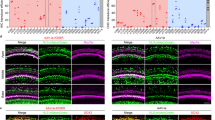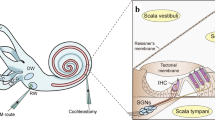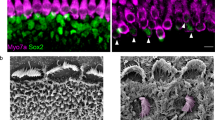Abstract
In the mammalian auditory system, sensory cell loss resulting from aging, ototoxic drugs, infections, overstimulation and other causes is irreversible and leads to permanent sensorineural hearing loss. To restore hearing, it is necessary to generate new functional hair cells. One potential way to regenerate hair cells is to induce a phenotypic transdifferentiation of nonsensory cells that remain in the deaf cochlea. Here we report that Atoh1, a gene also known as Math1 encoding a basic helix-loop-helix transcription factor and key regulator of hair cell development, induces regeneration of hair cells and substantially improves hearing thresholds in the mature deaf inner ear after delivery to nonsensory cells through adenovectors. This is the first demonstration of cellular and functional repair in the organ of Corti of a mature deaf mammal. The data suggest a new therapeutic approach based on expressing crucial developmental genes for cellular and functional restoration in the damaged auditory epithelium and other sensory systems.
This is a preview of subscription content, access via your institution
Access options
Subscribe to this journal
Receive 12 print issues and online access
$209.00 per year
only $17.42 per issue
Buy this article
- Purchase on Springer Link
- Instant access to full article PDF
Prices may be subject to local taxes which are calculated during checkout





Similar content being viewed by others
References
Fekete, D.M. Cell fate specification in the inner ear. Current Opin. Neurobiol. 6, 533–541 (1996).
Fekete, D.M. Making sense of making hair cells. Trends Neurosci. 23, 386 (2000).
Torres, M. & Giraldez, F. The development of the vertebrate inner ear. Mech. Dev. 71, 5–21 (1998).
Bermingham, N.A. et al. Math1: an essential gene for the generation of inner ear hair cells. Science 284, 1837–1841 (1999).
Chen, P., Johnson, J.E., Zoghbi, H.Y. & Segil, N. The role of Math1 in inner ear development: Uncoupling the establishment of the sensory primordium from hair cell fate determination. Development 129, 2495–2505 (2002).
Shou, J., Zheng, J.L. & Gao, W.Q. Robust generation of new hair cells in the mature mammalian inner ear by adenoviral expression of Hath1. Mol. Cell Neurosci. 23, 169–179 (2003).
Kawamoto, K., Ishimoto, S., Minoda, R., Brough, D.E. & Raphael, Y. Math1 gene transfer generates new cochlear hair cells in mature guinea pigs in vivo. J. Neurosci. 23, 4395–4400 (2003).
Hasson, T., Heintzelman, M.B., Santos-Sacchi, J., Corey, D.P. & Mooseker, M.S. Expression in cochlea and retina of myosin VIIa, the gene product defective in Usher syndrome type 1B. Proc. Nat. Acad. Sci. USA 92, 9815–9819 (1995).
Woods, C., Montcouquiol, M. & Kelley, M.W. Math1 regulates development of the sensory epithelium in the mammalian cochlea. Nat. Neurosci. 7, 1310–1318 (2004).
Greenwood, D.D. Critical bandwidth and the frequency coordinates of the basilar membrane. J. Acoust. Soc. Am. 33, 1344–1356 (1961).
Dallos, P. & Harris, D. Properties of auditory nerve responses in absence of outer hair cells. J. Neurophysiol. 41, 365–383 (1978).
Teas, D.C. & Nielsen, D.W. Interaural attenuation versus frequency for guinea pig and chinchilla CM response. J. Acoust. Soc. Am. 58, 1066–1072 (1975).
Zheng, J.L. & Gao, W.Q. Overexpression of Math1 induces robust production of extra hair cells in postnatal rat inner ears. Nat. Neurosci. 3, 580–586 (2000).
Cotanche, D.A., Messana, E.P. & Ofsie, M.S. Migration of hyaline cells into the chick basilar papilla during severe noise damage. Hear. Res. 91, 148–159 (1995).
Li, H., Liu, H. & Heller, S. Pluripotent stem cells from the adult mouse inner ear. Nat. Med. 9, 1293–1299 (2003).
Turner, C.W., Gantz, B.J., Vidal, C., Behrens, A. & Henry, B.A. Speech recognition in noise for cochlear implant listeners: benefits of residual acoustic hearing. J. Acoust. Soc. Am. 115, 1729–1735 (2004).
Ishimoto, S., Kawamoto, K., Kanzaki, S. & Raphael, Y. Gene transfer into supporting cells of the organ of Corti. Hear. Res. 173, 187–197 (2002).
Brough, D.E. et al. Activation of transgene expression by early region 4 is responsible for a high level of persistent transgene expression from adenovirus vectors in vivo. J. Virol. 71, 9206–9213 (1997).
Yamasoba, T. & Dolan, D.F. Chronic strychnine administration into the cochlea potentiates permanent threshold shift following noise exposure. Hear. Res. 112, 13–20 (1997).
Davis, H. Principles of electric response audiometry. Ann. Otol. Rhinol. Laryngol. 85 Suppl 28, 1–96 (1976).
Raphael, Y. & Altschuler, R.A. Reorganization of cytoskeletal and junctional proteins during cochlear hair cell degeneration. Cell Motil. Cytoskeleton 18, 215–227 (1991).
Raphael, Y. Reorganization of the chick basilar papilla after acoustic trauma. J. Comp. Neurol. 330, 521–532 (1993).
Beyer, L.A. et al. Hair cells in the inner ear of the pirouette and shaker 2 mutant mice. J. Neurocytol. 29, 227–240 (2000).
Yagi, M. et al. Spiral ganglion neurons are protected from degeneration by GDNF gene therapy. J. Assoc. Res. Otolaryngol. 1, 315–325. (2000).
Acknowledgements
We thank L.A. Beyer and L.L. Kabara for technical assistance. We thank P.F. Hitchcock and D.M. Martin for discussions and comments on the manuscript. This work was supported by a gift from B. and A. Hirschfield, by GenVec and by US National Institutes of Health–National Institute on Deafness and Other Communication Disorders grants R01 DC01634, DC05401 and P30 DC05188. We thank P.J. Olynyk for graphics work on the cover illustration.
Author information
Authors and Affiliations
Corresponding author
Ethics declarations
Competing interests
D.E. Brough is employed by GenVec. GenVec provided viral vectors and support for this work.
Rights and permissions
About this article
Cite this article
Izumikawa, M., Minoda, R., Kawamoto, K. et al. Auditory hair cell replacement and hearing improvement by Atoh1 gene therapy in deaf mammals. Nat Med 11, 271–276 (2005). https://doi.org/10.1038/nm1193
Received:
Accepted:
Published:
Issue Date:
DOI: https://doi.org/10.1038/nm1193
This article is cited by
-
Stem Cell-Based Hair Cell Regeneration and Therapy in the Inner Ear
Neuroscience Bulletin (2024)
-
The proper timing of Atoh1 expression is pivotal for hair cell subtype differentiation and the establishment of inner ear function
Cellular and Molecular Life Sciences (2023)
-
Gene Therapy for Congenital Hearing Loss
Current Otorhinolaryngology Reports (2022)
-
Stem Cells and Gene Therapy in Progressive Hearing Loss: the State of the Art
Journal of the Association for Research in Otolaryngology (2021)
-
Combinatorial Atoh1 and Gfi1 induction enhances hair cell regeneration in the adult cochlea
Scientific Reports (2020)



